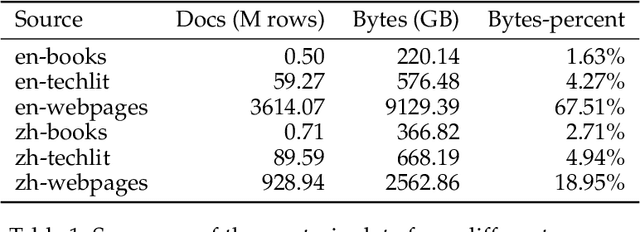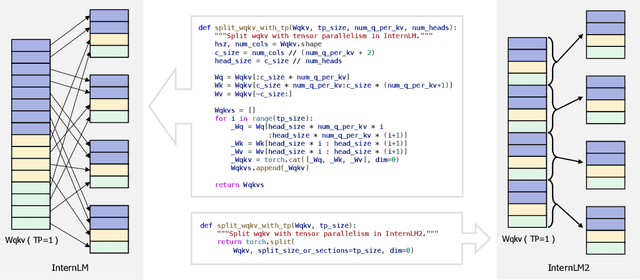Maosong Cao
OmniAlign-V: Towards Enhanced Alignment of MLLMs with Human Preference
Feb 25, 2025Abstract:Recent advancements in open-source multi-modal large language models (MLLMs) have primarily focused on enhancing foundational capabilities, leaving a significant gap in human preference alignment. This paper introduces OmniAlign-V, a comprehensive dataset of 200K high-quality training samples featuring diverse images, complex questions, and varied response formats to improve MLLMs' alignment with human preferences. We also present MM-AlignBench, a human-annotated benchmark specifically designed to evaluate MLLMs' alignment with human values. Experimental results show that finetuning MLLMs with OmniAlign-V, using Supervised Fine-Tuning (SFT) or Direct Preference Optimization (DPO), significantly enhances human preference alignment while maintaining or enhancing performance on standard VQA benchmarks, preserving their fundamental capabilities. Our datasets, benchmark, code and checkpoints have been released at https://github.com/PhoenixZ810/OmniAlign-V.
Condor: Enhance LLM Alignment with Knowledge-Driven Data Synthesis and Refinement
Jan 21, 2025



Abstract:The quality of Supervised Fine-Tuning (SFT) data plays a critical role in enhancing the conversational capabilities of Large Language Models (LLMs). However, as LLMs become more advanced, the availability of high-quality human-annotated SFT data has become a significant bottleneck, necessitating a greater reliance on synthetic training data. In this work, we introduce Condor, a novel two-stage synthetic data generation framework that incorporates World Knowledge Tree and Self-Reflection Refinement to produce high-quality SFT data at scale. Our experimental results demonstrate that a base model fine-tuned on only 20K Condor-generated samples achieves superior performance compared to counterparts. The additional refinement stage in Condor further enables iterative self-improvement for LLMs at various scales (up to 72B), validating the effectiveness of our approach. Furthermore, our investigation into the scaling for synthetic data in post-training reveals substantial unexplored potential for performance improvements, opening promising avenues for future research.
CompassJudger-1: All-in-one Judge Model Helps Model Evaluation and Evolution
Oct 21, 2024



Abstract:Efficient and accurate evaluation is crucial for the continuous improvement of large language models (LLMs). Among various assessment methods, subjective evaluation has garnered significant attention due to its superior alignment with real-world usage scenarios and human preferences. However, human-based evaluations are costly and lack reproducibility, making precise automated evaluators (judgers) vital in this process. In this report, we introduce \textbf{CompassJudger-1}, the first open-source \textbf{all-in-one} judge LLM. CompassJudger-1 is a general-purpose LLM that demonstrates remarkable versatility. It is capable of: 1. Performing unitary scoring and two-model comparisons as a reward model; 2. Conducting evaluations according to specified formats; 3. Generating critiques; 4. Executing diverse tasks like a general LLM. To assess the evaluation capabilities of different judge models under a unified setting, we have also established \textbf{JudgerBench}, a new benchmark that encompasses various subjective evaluation tasks and covers a wide range of topics. CompassJudger-1 offers a comprehensive solution for various evaluation tasks while maintaining the flexibility to adapt to diverse requirements. Both CompassJudger and JudgerBench are released and available to the research community athttps://github.com/open-compass/CompassJudger. We believe that by open-sourcing these tools, we can foster collaboration and accelerate progress in LLM evaluation methodologies.
InternLM-Law: An Open Source Chinese Legal Large Language Model
Jun 21, 2024Abstract:While large language models (LLMs) have showcased impressive capabilities, they struggle with addressing legal queries due to the intricate complexities and specialized expertise required in the legal field. In this paper, we introduce InternLM-Law, a specialized LLM tailored for addressing diverse legal queries related to Chinese laws, spanning from responding to standard legal questions (e.g., legal exercises in textbooks) to analyzing complex real-world legal situations. We meticulously construct a dataset in the Chinese legal domain, encompassing over 1 million queries, and implement a data filtering and processing pipeline to ensure its diversity and quality. Our training approach involves a novel two-stage process: initially fine-tuning LLMs on both legal-specific and general-purpose content to equip the models with broad knowledge, followed by exclusive fine-tuning on high-quality legal data to enhance structured output generation. InternLM-Law achieves the highest average performance on LawBench, outperforming state-of-the-art models, including GPT-4, on 13 out of 20 subtasks. We make InternLM-Law and our dataset publicly available to facilitate future research in applying LLMs within the legal domain.
InternLM2 Technical Report
Mar 26, 2024



Abstract:The evolution of Large Language Models (LLMs) like ChatGPT and GPT-4 has sparked discussions on the advent of Artificial General Intelligence (AGI). However, replicating such advancements in open-source models has been challenging. This paper introduces InternLM2, an open-source LLM that outperforms its predecessors in comprehensive evaluations across 6 dimensions and 30 benchmarks, long-context modeling, and open-ended subjective evaluations through innovative pre-training and optimization techniques. The pre-training process of InternLM2 is meticulously detailed, highlighting the preparation of diverse data types including text, code, and long-context data. InternLM2 efficiently captures long-term dependencies, initially trained on 4k tokens before advancing to 32k tokens in pre-training and fine-tuning stages, exhibiting remarkable performance on the 200k ``Needle-in-a-Haystack" test. InternLM2 is further aligned using Supervised Fine-Tuning (SFT) and a novel Conditional Online Reinforcement Learning from Human Feedback (COOL RLHF) strategy that addresses conflicting human preferences and reward hacking. By releasing InternLM2 models in different training stages and model sizes, we provide the community with insights into the model's evolution.
InternLM-XComposer2: Mastering Free-form Text-Image Composition and Comprehension in Vision-Language Large Model
Jan 29, 2024Abstract:We introduce InternLM-XComposer2, a cutting-edge vision-language model excelling in free-form text-image composition and comprehension. This model goes beyond conventional vision-language understanding, adeptly crafting interleaved text-image content from diverse inputs like outlines, detailed textual specifications, and reference images, enabling highly customizable content creation. InternLM-XComposer2 proposes a Partial LoRA (PLoRA) approach that applies additional LoRA parameters exclusively to image tokens to preserve the integrity of pre-trained language knowledge, striking a balance between precise vision understanding and text composition with literary talent. Experimental results demonstrate the superiority of InternLM-XComposer2 based on InternLM2-7B in producing high-quality long-text multi-modal content and its exceptional vision-language understanding performance across various benchmarks, where it not only significantly outperforms existing multimodal models but also matches or even surpasses GPT-4V and Gemini Pro in certain assessments. This highlights its remarkable proficiency in the realm of multimodal understanding. The InternLM-XComposer2 model series with 7B parameters are publicly available at https://github.com/InternLM/InternLM-XComposer.
EIPE-text: Evaluation-Guided Iterative Plan Extraction for Long-Form Narrative Text Generation
Oct 12, 2023



Abstract:Plan-and-Write is a common hierarchical approach in long-form narrative text generation, which first creates a plan to guide the narrative writing. Following this approach, several studies rely on simply prompting large language models for planning, which often yields suboptimal results. In this paper, we propose a new framework called Evaluation-guided Iterative Plan Extraction for long-form narrative text generation (EIPE-text), which extracts plans from the corpus of narratives and utilizes the extracted plans to construct a better planner. EIPE-text has three stages: plan extraction, learning, and inference. In the plan extraction stage, it iteratively extracts and improves plans from the narrative corpus and constructs a plan corpus. We propose a question answer (QA) based evaluation mechanism to automatically evaluate the plans and generate detailed plan refinement instructions to guide the iterative improvement. In the learning stage, we build a better planner by fine-tuning with the plan corpus or in-context learning with examples in the plan corpus. Finally, we leverage a hierarchical approach to generate long-form narratives. We evaluate the effectiveness of EIPE-text in the domains of novels and storytelling. Both GPT-4-based evaluations and human evaluations demonstrate that our method can generate more coherent and relevant long-form narratives. Our code will be released in the future.
Progressive Attention Guidance for Whole Slide Vulvovaginal Candidiasis Screening
Sep 06, 2023Abstract:Vulvovaginal candidiasis (VVC) is the most prevalent human candidal infection, estimated to afflict approximately 75% of all women at least once in their lifetime. It will lead to several symptoms including pruritus, vaginal soreness, and so on. Automatic whole slide image (WSI) classification is highly demanded, for the huge burden of disease control and prevention. However, the WSI-based computer-aided VCC screening method is still vacant due to the scarce labeled data and unique properties of candida. Candida in WSI is challenging to be captured by conventional classification models due to its distinctive elongated shape, the small proportion of their spatial distribution, and the style gap from WSIs. To make the model focus on the candida easier, we propose an attention-guided method, which can obtain a robust diagnosis classification model. Specifically, we first use a pre-trained detection model as prior instruction to initialize the classification model. Then we design a Skip Self-Attention module to refine the attention onto the fined-grained features of candida. Finally, we use a contrastive learning method to alleviate the overfitting caused by the style gap of WSIs and suppress the attention to false positive regions. Our experimental results demonstrate that our framework achieves state-of-the-art performance. Code and example data are available at https://github.com/cjdbehumble/MICCAI2023-VVC-Screening.
* Accepted in the main conference MICCAI 2023
CellGAN: Conditional Cervical Cell Synthesis for Augmenting Cytopathological Image Classification
Jul 12, 2023Abstract:Automatic examination of thin-prep cytologic test (TCT) slides can assist pathologists in finding cervical abnormality for accurate and efficient cancer screening. Current solutions mostly need to localize suspicious cells and classify abnormality based on local patches, concerning the fact that whole slide images of TCT are extremely large. It thus requires many annotations of normal and abnormal cervical cells, to supervise the training of the patch-level classifier for promising performance. In this paper, we propose CellGAN to synthesize cytopathological images of various cervical cell types for augmenting patch-level cell classification. Built upon a lightweight backbone, CellGAN is equipped with a non-linear class mapping network to effectively incorporate cell type information into image generation. We also propose the Skip-layer Global Context module to model the complex spatial relationship of the cells, and attain high fidelity of the synthesized images through adversarial learning. Our experiments demonstrate that CellGAN can produce visually plausible TCT cytopathological images for different cell types. We also validate the effectiveness of using CellGAN to greatly augment patch-level cell classification performance.
 Add to Chrome
Add to Chrome Add to Firefox
Add to Firefox Add to Edge
Add to Edge